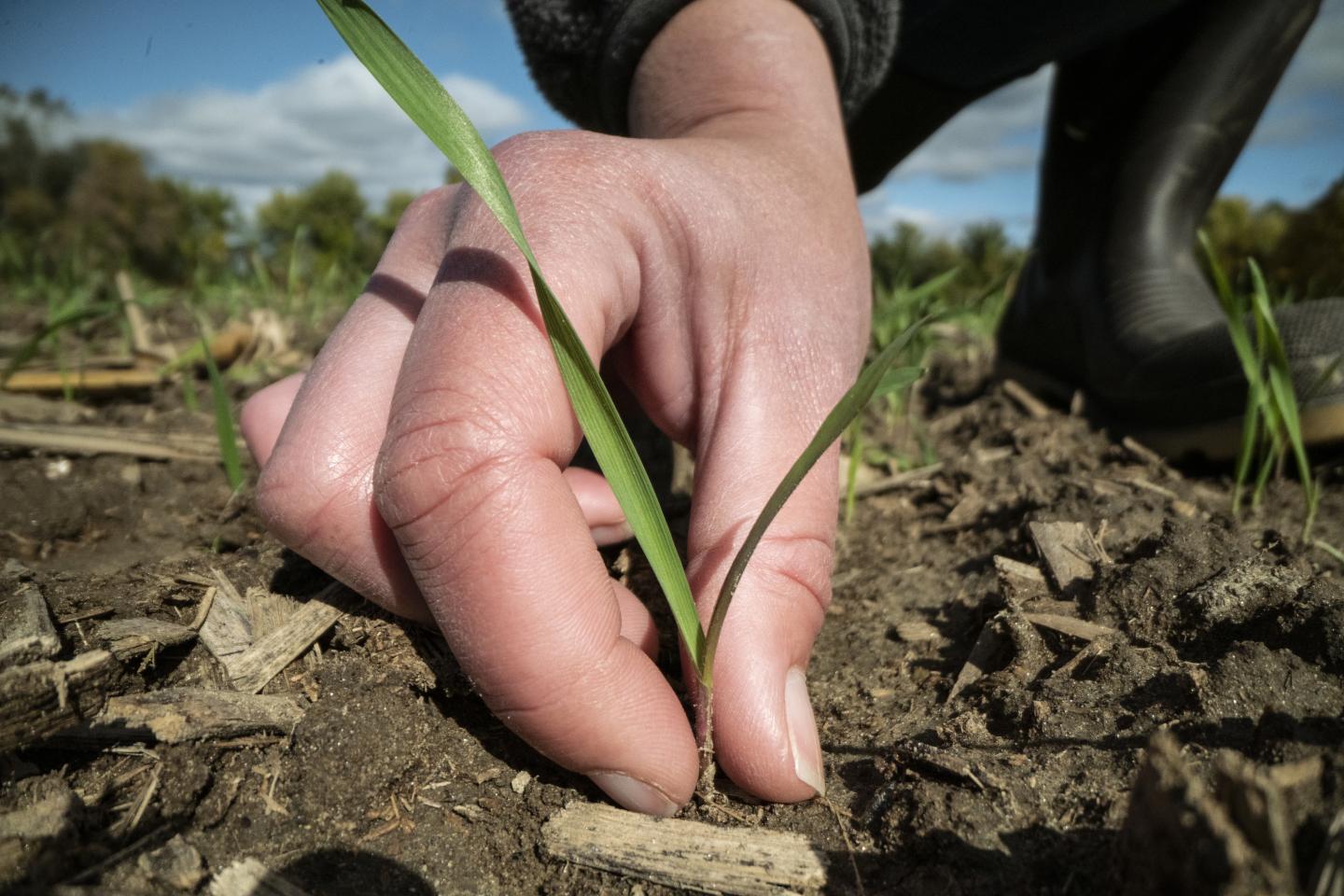
Agricultural producers continually search for ways to increase profitability while being good land stewards. Becoming energy efficient is one process that benefits a farm’s bottom line and supports energy independence, improves air quality, reduces air pollutants and greenhouse gas emissions.
This emerging agricultural trend produces benefits, including reduced input costs, increased productivity per unit of energy consumed by equipment and lighting, and reduced air pollutants and greenhouse gas emissions caused when energy is generated for agricultural use.
Financial assistance is available to inventory and analyze farm systems that use energy and identify opportunities to improve efficiency through the development of an Agricultural Energy Management Plan (AgEMP). The AgEMP, or energy audit, is completed by NRCS-certified Technical Service Providers (TSPs) and provides:
- Itemized energy use by individual systems to establish a baseline for electricity and other fuel improvements,
- Recommendations for equipment improvements and upgrades,
- Potential energy reductions and financial savings for each recommendation
- Cost estimates of potential improvements, and
- Length of expected payback for energy efficiency upgrades
Once an AgEMP or other qualifying energy audit has been completed, eligible producers can apply for EQIP assistance for the purchase, installation, or retrofit of certain buildings or equipment to improve energy efficiency. Examples of items eligible for energy efficiency improvements include:
- Lighting
- Plate coolers
- Ventilation and fans
- Irrigation pumps
- Grain dryers
- Greenhouse improvements
- Maple syrup evaporators
- Heating and refrigeration units
- Insulation and building envelope sealing
- Motor controls and variable speed drive
Learn more information about on-farm energy efficiency.
Additional Information
- Energy Efficient Agricultural Operation (374)
- Energy Efficient Building Envelope (672)
- Energy Efficient Lighting System (670)

Oregon's On-Farm Energy Initiative
Counties: Baker, Benton, Clackamas, Clatsop, Columbia, Coos, Crook, Curry, Deschutes, Douglas, Gilliam, Grant, Harney, Hood River, Jackson, Jefferson, Josephine, Klamath, Lake, Lane, Lincoln, Linn, Malheur, Marion, Morrow, Multnomah, Polk, Sherman, Tillamook, Umatilla, Union, Wallowa, Wasco, Washington, Wheeler, Yamhill
Primary Resource Concern Addressed
- Inefficient Energy Use – Energy efficiency of equipment and facilities
- Inefficient Energy Use – Energy efficient of farming/ranching practices and field operations
Purpose
Financial assistance is available to inventory and analyze farm systems that use energy and identify opportunities to improve efficiency through the development of an Agricultural Energy Assessment. The Agricultural Energy Assessment, or energy audit, is completed by NRCS-certified Technical Service Providers (TSPs) and provides:
- Itemized energy use by individual systems to establish a baseline for electricity and other fuel improvements
- Recommendations for equipment improvements and upgrades
- Potential energy reductions and financial savings for each recommendation
- Cost estimates of potential improvement
- Length of expected payback for energy efficiency upgrades
One an Agricultural Energy Assessment or other qualifying energy audit has been completed, eligible producers can apply for EQIP assistance for the purchase, installation or retrofit of certain buildings or equipment to improve energy efficiency.
Conservation Practices Offered:
- Agricultural Energy Design (120)
- Agricultural Energy Assessment (228)
- Conservation Crop Rotation (328)
- Residue and Tillage Management, No Till (329)
- Cover Crop (340)
- Residue and Tillage Management, Reduced Till (345)
- Combustion System Improvement (372)
- Energy Efficient Agricultural Operation (374)
- Windbreak/Shelterbelt Establishment and Renovation (380)
- Irrigation Ditch Lining (428)
- Irrigation Pipeline (430)
- Irrigation Reservoir (436)
- Irrigation System, Microirrigation (441)
- Sprinkler System (442)
- Irrigation System, Surface and Subsurface (443)
- Irrigation Water Management (449)
- Livestock Pipeline (516)
- Pumping Plant (533)
- Terrace (600)
- Energy Efficient Lighting System (670)
- Energy Efficient Building Envelope (672)
Ranking Questions:
1) Do practices utilize potential pressurized waterpower to reduce energy demand?
2) How much will energy efficiency improve?
- a. Energy efficiency improved to reduce by 1-5 horsepower
- b. Energy efficiency improved to reduce by 6-10 horsepower
- c. Energy efficiency improved to reduce by 10+ horsepower
- d. Energy efficiency improved by installing a Variable Frequency Drive pump.
3) Is water seepage loss reduced by transitioning from open ditch to pipeline?
4) Community Based Conservation Support for the project (select one option):
- a. The system has one user and there is a draft operation and maintenance plan.
- b. The system has multiple users and there is an established operation and maintenance plan
- c. The system has multiple users and there is a draft operation and maintenance plan.
- d. The system has multiple users and there is no operation and maintenance plan.
5) Irrigation efficiency is estimated to improve by:
- a. 40 ac.in/ or more
- b. Irrigation efficiency estimates improved by 35-39 ac.in/ ac
- c. 31-34 ac.in/ac
- d. 25-27 ac.in/ac
- e. 1-24 ac.in/ac
Related Information
Ready to get started?
Contact your local service center to start your application.
How to Get Assistance
Do you farm or ranch and want to make improvements to the land that you own or lease?
Natural Resources Conservation Service offers technical and financial assistance to help farmers, ranchers and forest landowners.

To get started with NRCS, we recommend you stop by your local NRCS field office. We’ll discuss your vision for your land.
NRCS provides landowners with free technical assistance, or advice, for their land. Common technical assistance includes: resource assessment, practice design and resource monitoring. Your conservation planner will help you determine if financial assistance is right for you.
We’ll walk you through the application process. To get started on applying for financial assistance, we’ll work with you:
- To fill out an AD 1026, which ensures a conservation plan is in place before lands with highly erodible soils are farmed. It also ensures that identified wetland areas are protected.
- To meet other eligibility certifications.
Once complete, we’ll work with you on the application, or CPA 1200.
Applications for most programs are accepted on a continuous basis, but they’re considered for funding in different ranking periods. Be sure to ask your local NRCS district conservationist about the deadline for the ranking period to ensure you turn in your application in time.
As part of the application process, we’ll check to see if you are eligible. To do this, you’ll need to bring:
- An official tax ID (Social Security number or an employer ID)
- A property deed or lease agreement to show you have control of the property; and
- A farm number.
If you don’t have a farm number, you can get one from USDA’s Farm Service Agency. Typically, the local FSA office is located in the same building as the local NRCS office. You only need a farm number if you’re interested in financial assistance.
NRCS will take a look at the applications and rank them according to local resource concerns, the amount of conservation benefits the work will provide and the needs of applicants. View Application Ranking Dates by State.
If you’re selected, you can choose whether to sign the contract for the work to be done.
Once you sign the contract, you’ll be provided standards and specifications for completing the practice or practices, and then you will have a specified amount of time to implement. Once the work is implemented and inspected, you’ll be paid the rate of compensation for the work if it meets NRCS standards and specifications.

